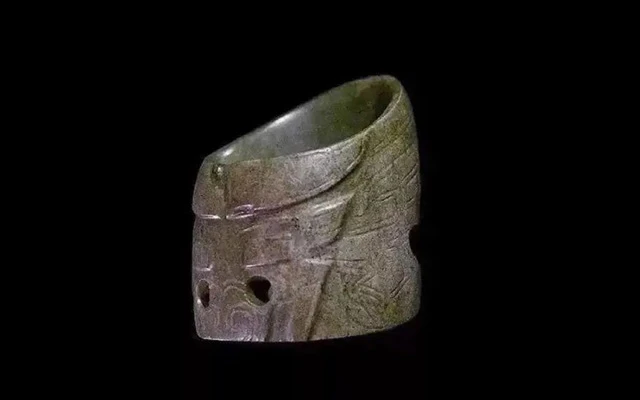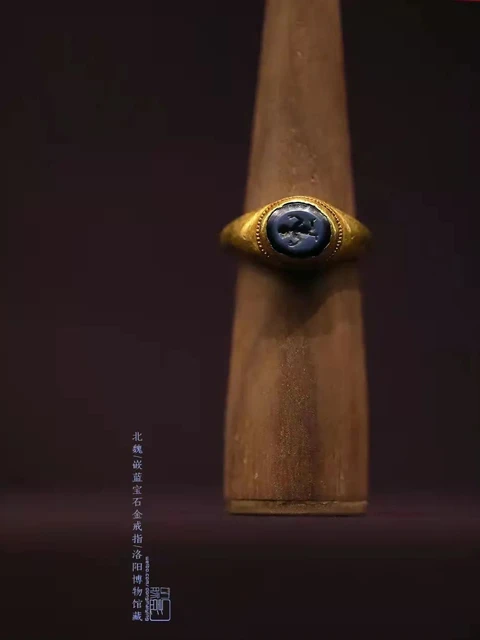For thousands of years, the Chinese have used rings to symbolize essential events, births, deaths, weddings, anniversaries, etc. The rings are generally worn by the oldest person present and passed down through generations.
While the modern ring represents romantic love and commitment, what are the symbolic meanings of the traditional rings in Chinese history? Let's go into the past life of the ring.
Ancient - The Ring of Bone
More than 5,000 years ago, when humankind was still in its primitive society, the "ring" was already born. At that time, it did not have an exact name, but was just a ring-shaped object worn on people's fingers.

Neolithic period - bone ring
In 1959, archaeologists found twenty traditional rings in the burials of the Dawenkou Longshan culture in Tai'an, Shandong province. Several of them are still worn on the finger bones of the deceased.
These rings were made from natural animal bones, tooth bones, jade, etc. Although the process was simple, they were well made, and the surface was polished smooth, and some were inlaid with turquoise. This is the earliest "ring" found in China. It appeared in people's daily lives before records about it in history books.
Yin Shang - The Ring of Valor
In the Classic of Poetry - Wan Lan, it is written that "a child wore the leaves of Wan Lan as a She," which means that the leaves of the Metaplexis were rolled into a tube, just like the She worn by a child.

The Warring States - jade She ring
She (韘) is an ornament popular during the Spring and Autumn and Warring States period. It first appeared in the Yin and Shang dynasties and was a finger ring made of jade, bone, and wood for archery purposes.
Because the bowstring is thin, repeatedly pulling and tugging easily lead to thumb abrasion; wear this special ring - She on it, it can effectively play a protective role. Its shape and function are similar to what is known today as the "thumb ring," so it is regarded as the originator of the thumb ring.

Qing Dynasty - thumb ring - collection of the Palace Museum
Fu Hao was the wife of the Shang monarch Wu Ding, who was the first female military commander in China and led her army to expand the territory. In her tomb, a jade She was found. It is shaped like a short tube, with one flush end and a slanted end, and is carved with an exquisite animal face decoration, with two small holes under the animal face, so that what can tie it to the wrist with a thin rope.

Shang Dynasty - jade She - excavated from the tomb of Fuhao at Yinxu
This small jade ring has come through 4,000 years, so it is clear that at that time, the ring was widely made and used, only it did not have a moral about love, but more as military use.
Qin and Han - The Ring of Prohibition
During the Qin and Han dynasties, what gave the ring a new name, the "Yue Zhi (约指)." At that time, the ring was a sign of whether the consort in the imperial palace could serve in bed.
Every time night fell, female officers distributed "rings" to the consorts of the palace according to the rules. Those who could not serve were issued gold rings; those who were fit to serve were given silver rings to wear on the left hand, and those who had already served wore the right hand.
Consorts wear it is not to show off the beauty, but up to restrain. This may also be the origin of "Jie Zhi (戒指)".

Northern Wei Dynasty - inlaid sapphire gold ring - collection of the Luoyang Museum
Of course, at that time, there were some other meanings about the ring that also began to be popular. Dong Zhongshu, the master of Confucianism in the Western Han Dynasty, linked the ring with ghosts and demons and believed that what could ward off the worn ring demons and evil spirits and reduce disasters and bad luck.
Tang - The Ring of Occult
The occult meaning carried by the ring continued into the Tang Dynasty, and various ghostly legends related to the ring emerged.
In a collection of strange novels compiled by Yan Zhitui of the Northern Qi Dynasty, "Ji Ling Ji (集灵记)," there is a story about traditional rings.
Wang Xu is Yan Zhitui's hometown in Langya; after his death, his ghost saw his wife and daughter living in hardship, so he entrusted a dream and said, if I get rich, I will send you. Soon after, the daughter did turn up a pair of rings.
Wang Xu was Yan Zhitui's hometown in Langya; after his death, the ghost saw his wife and daughter living in hardship and told them in a dream that if he became rich, he would send it to them. Soon after, the daughter find out a pair of rings at home.

Tang Dynasty - sapphire ring - collection of Turan County Museum
There are countless stories like this one. In these stories, rings carry a mystical overtone and appear as a spiritual element. However, by the Tang Dynasty, a more refreshing meaning of the ring also appeared in the poetry.
In the legendary novel "Biography of Li Zhang Wu" written by Li Jingliang in the Tang Dynasty, it was reported that Li Zhang Wu and Zi Fu were facing separation, and they were very reluctant to leave each other and gave each other tokens. Among them, Zi Fu gave a "white jade ring."
Perhaps from then on, the ring took on a new meaning, not just concerning ghosts and spirits, but as a token of love - the shape of the circle represents the meaning of "no end to the cycle," implying the love between lovers.
Song, Ming, and Qing - The Ring of Love
A touch of love warmth given to the ring by the people of the Tang Dynasty laid the foundation for the development of the ring as a marriage dowry after the Song Dynasty.
The association of rings with marriage originally originated from Hu custom. During the Wei, Jin and North and South Dynasties, warfare was frequent and brought about a great intermingling of national cultures.

Northern Song Dynasty - Engraved Silver Ring - collection of Zhejiang Museum
After the Song Dynasty, the custom of the ring as a token of marriage spread among the people. In the Song Dynasty, rich and noble families must prepare a bride price of "three gold": gold rings, gold bracelets, gold Peizhui, to express the husband's family to the future daughter-in-law's importance and love. Since then, the ring has officially as a folk wedding custom standard debut.

Ming dynasty - inlaid gemstone ring - collection of Hebi Museum Collection
Ming Dynasty unearthed quite a few traditional rings, gold dragon head with beads ring, silver-gilt baby play ring, gold with treasure gourd ring.

Qing dynasty - gold and pearl ring - collection of the Palace Museum
Until the Qing Dynasty, with the Manchu culture into the Central Plains, the ring into the royal bride price list.
As one of the vital bride prices, traditional rings, directly linked to the owner's status of respect, is to show the level of gold and silver jewelry.

Qing Dynasty - white gold with sapphires ring - collection of the Palace Museum
At the end of the Qing Dynasty, traditional rings also began to be used as a souvenir of engagement. Today, the meaning of the ring has become the consensus of everyone, without much explanation.
Throughout the history of the development of the traditional ring, from a primitive bone ring buried in the land to a mysterious power of the spirit, and then to a token of sincere love, human beings injected it with infinite honey and tenderness so that the original cold object becomes warm.
This is perhaps the romance of the ancients and the persistent pursuit of beauty engraved in the bones of humankind.






waw😍😍
Sampai sekarang cincin menjadi simbol ikatan
Cincin pada zaman dulu sangat unik